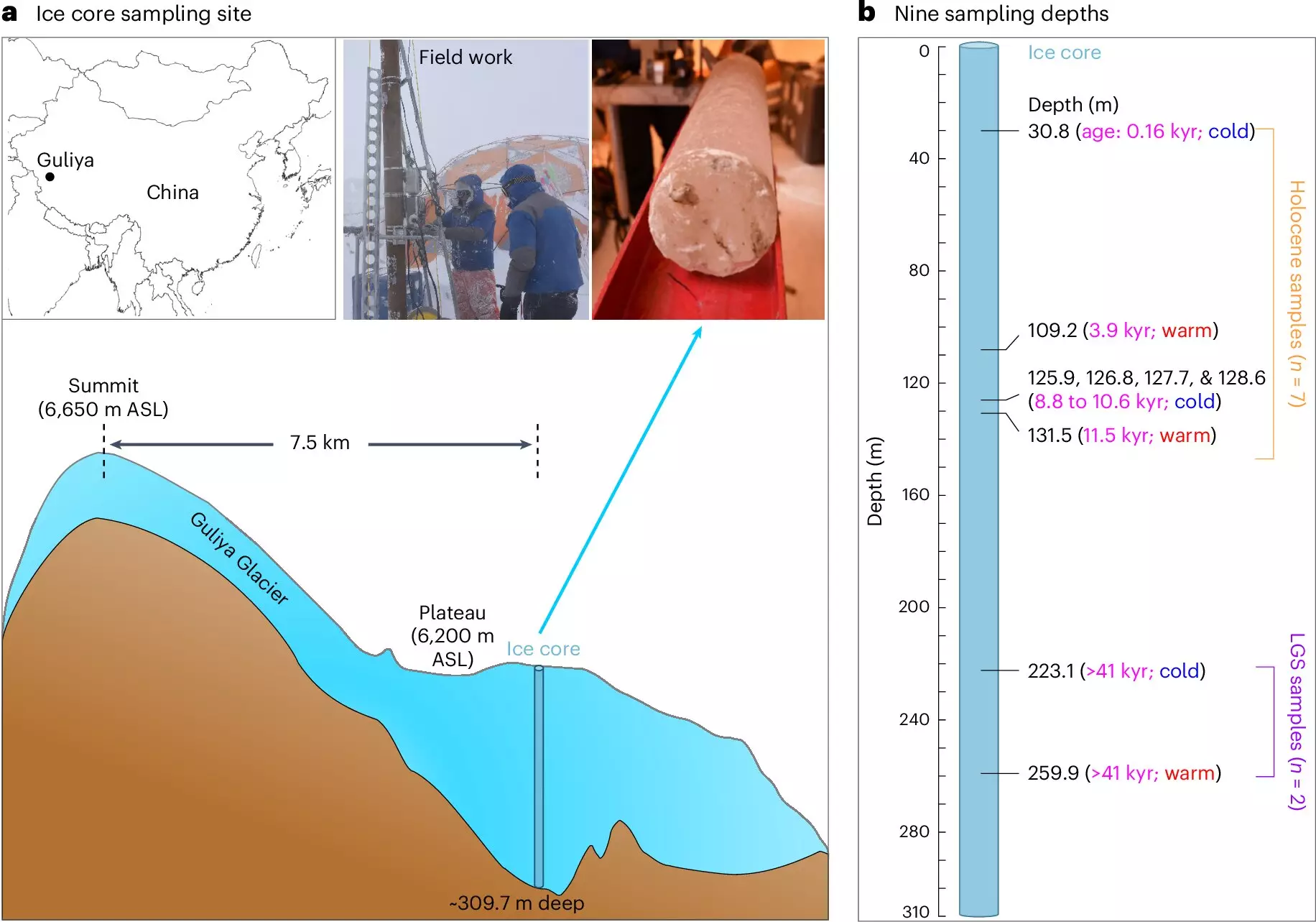The Guliya Glacier, perched high in the Tibetan Plateau, presents a remarkable opportunity for scientists to delve deep into the past and understand how climate change has influenced life on Earth. An intriguing new study highlights how glacial ice, often viewed as a frozen relic, serves as a remarkable archive containing ancient viruses that carry critical information regarding Earth’s climatic transitions. With the Guliya Glacier sitting above 20,000 feet, these ice cores contain records that extend back over 41,000 years, offering a unique glimpse into prehistoric ecosystems shaped by severe climate fluctuations.
The recent research conducted by a dedicated team of microbiologists has unearthed nearly 1,700 distinct viral species from recovered ice core samples, with more than three-quarters being previously undocumented. Such findings unveil the hidden, dynamic world of ancient microorganisms and their evolutionary adaptations in response to changing environmental conditions over millennia. Indeed, the ice acts as a time capsule, capturing snapshots of life’s microbial responses to past climate shifts.
The Role of Viruses in Climate Adaptation
Dr. ZhiPing Zhong, the lead author of the study from The Ohio State University, emphasized the significance of this research, stating, “Before this work, how viruses linked to large-scale changes in Earth’s climate had remained largely uninvestigated.” Through advanced genetic sequencing techniques, the team was able to reconstruct pieces of viral DNA that had long remained dormant within the ice. Interestingly, the viruses discovered are not seen as a direct threat to modern human populations; they are believed to have infected ancient microbial hosts, which underwent adaptations that likely enhanced their resilience during significant climatic shifts.
Among the most compelling results from the study is a viral community that dates back approximately 11,500 years, coinciding with the transition from the Last Glacial Stage to the warm Holocene epoch. This period marks a transformative era in Earth’s history, and the presence of viruses during this time hints at a potential link between viral evolution and broader ecological responses to climate change.
The Implications of Viral Research
The implications of studying ancient viruses are far-reaching. By investigating the genetic signatures and adaptations of these viruses, researchers can glean valuable insights into how contemporary viruses might respond to current and future climate scenarios. The continuous warming of our planet poses urgent questions about how ecosystems, including microbiomes, will adapt to these changes. As noted by Dr. Matthew Sullivan, co-author of the study, the collaboration between different scientific disciplines at Ohio State has fostered a richer understanding of these complex interactions.
Furthermore, the presence of some viral species in the Guliya Glacier that overlap with those from vastly different regions, such as the Arctic and the Middle East, indicates potential avenues for the spread and evolution of viruses across significant distances. This highlights the interconnectedness of life’s microbial forms, making viral research an integral part of understanding planetary health in an era of global climate change.
As glaciers around the world continue to melt at unprecedented rates due to climate change, the urgency to analyze and collect ice cores has intensified. With every passing year, the opportunity to study these ancient viruses diminishes. The research team’s work underscores the need to act quickly in order to preserve these invaluable resources before they vanish forever. The interplay between warming temperatures and rapidly disappearing glacial ice presents a dire challenge for scientists aiming to unlock the climate secrets contained within.
The study also delineates the importance of interdisciplinary research methods, combining knowledge from microbiology, climatic studies, and earth sciences—all vital to devising holistic solutions: “This kind of opportunity represents several disciplines coming together, each with their own scientific languages as a barrier to proceed,” Sullivan remarked. This conducive environment for scientific inquiry may provide innovative strategies for tackling pressing climate-related questions.
The insights gathered from ancient viruses may extend beyond Earth, offering potential tools for understanding life in extraterrestrial environments, such as on Mars or other icy bodies in our solar system. The advanced techniques honed in these findings could aid efforts to identify microbial life in places previously deemed inhospitable. As Dr. Lonnie Thompson aptly noted, “If we work together, these techniques have much potential to help us start tackling a large array of scientific issues.” This paves the way for future research that could revolutionize our understanding of life across the cosmos.
The study of ancient viruses preserved in glacial ice not only sheds light on Earth’s climatic past but also opens the door to understanding future microbial behavior amid ongoing environmental changes. The interdisciplinary collaboration and innovative methodologies characteristic of this research epitomize the potential for transformative scientific discoveries, highlighting the pressing need to preserve our planet’s icy landscapes for generations to come.

